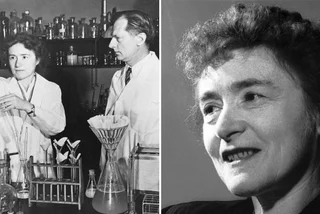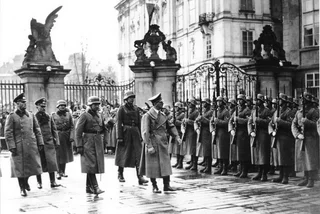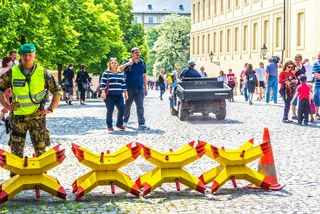Women have significantly shaped history since the dawn of the Czech lands. From the mythical Princess Libuše who prophesized the city of Prague to Ludmila, the first actual Czech princess, who raised the nation's patron saint, Wenceslas, and was herself sainted after her murder over a thousand years ago.
Other women, too numerous to name here, made significant contributions to Czech history. Some remain footnotes, less well-known than the men of their day, while others never lived to revel in the acclaim owed to them.
To read more about the heroines of Czech history on International Women's Day, the archive of the exhibit "Hrdinky - Příběhy významných českých žen" (Heroines - Stories of Important Czech Women), based on a book and presented by the Czech Centres, can be found in English here.
The anti-defenestration dame

Polyxena of Lobkowicz is remembered for donating the wax statue called the Infant of Prague to the Carmelite nuns at the Church of Our Lady Victorious, where the statue still stands. Her more important contributions to diplomacy are all but forgotten. By birth, she had ties to both Bohemian and Spanish Hapsburg nobility and was able to serve as a liaison between both sides. Her second husband was the Imperial High Chancellor Zdeněk Vojtěch Popel of Lobkowitz.
The Second Defenestration of Prague occurred in 1618 at the Bohemian Chancellery, part of the Old Royal Palace. Protestant hardliners threw three representatives Holy Roman Emperor Ferdinand II, a Catholic, out of a window for a 20-meter drop. The three survived but were still pursued by the hardliners. Polyxena gave refuge to two of the three injured Catholic envoys at the nearby Lobkowicz Palace, where Polyxena of Lobkowicz was in residence.
Kafka's freedom-fighting muse

Milena Jesenská is remembered as the recipient of letters from surrealist writer Franz Kafka. She was more than just his friend, though. She also translated his work from the original German into Czech. At the end of his life, Kafka turned his diaries over to her.
Jesenská was a writer on her own, contributing columns to prominent Czech newspapers. She became editor of the political and cultural magazine Přítomnost (Presence) in 1938. She used the platform to oppose the rise of the Nazi party and warn people of the dangers that Czechoslovakia faced.
When the Nazis occupied Bohemia she took part in the resistance by helping families to emigrate. Her efforts inspired Sir Nicholas Winton, who is known for organizing transportation for Jewish children on the eve of World War II.
She stayed, though, and was arrested by the Gestapo in November 1939. After being sent to prisons in Prague and Dresden, she was moved to the concentration camp at Ravensbrück. She continued to try to help prisoners there. She died of kidney failure on May 17, 1944, at age 47. Her friend from the camp, Margarete Buber-Neumann, wrote her biography after the war. She was recognized by the Yad Vashem Holocaust Memorial as Righteous Among the Nations in 1994.
A javelin boss who gave her husband a run for his money

While the film “Zátopek,” which just swept the Czech Lion Awards, focused on runner Emil Zátopek, his wife and fellow athlete Dana Zátopková also made a mark in the sport of javelin throwing.
She won a gold medal in the 1952 Olympics and silver in the 1960 Olympics. She also won gold twice at the European Championships, in 1954 and 1958, the latter with a world record throw of 55.73 meters. She also earned 14 gold medals at the Czechoslovak Athletics Championships between 1946 and 1950. From the 1960s onward, she devoted herself to coaching and from 1960 to ’72 was on the women’s commission of the International Association of Athletics Federations (IAAF).
She died at the age of 97 on March 13, 2020. Due to the Covid pandemic, only a small funeral was allowed. Many sports figures from around the world who would have attended sent condolences.
The original Czech influencer and business woman

In the interwar period, Czechoslovakia was becoming a fashion center, and Hana Podolská was the country’s most sought-after designer. One innovation she brought to the Czech scene was twice-yearly fashion shows using live models who were selected for their looks and poise. She began in the fashion industry in 1908 and hit her stride after World War I.
Podolská’s sartorial creations were seen on movie stars, celebrities, and wives of successful artists and businessmen. Her models appeared in fashion magazines. By dressing famous opera stars of the day, her clothes were seen around the world.
The fashion house survived World War II, but the communist coup of 1948 brought an end to bourgeois fashions. The shop was nationalized, and she ended her career as a clerk in the store she used to own. She died in 1972 at the age of 91. In 1997, her tombstone vanished, allegedly sold by her former caregiver. The “Coco Chanel of Czechoslovakia” is now in an unmarked grave in Olšanské hřbitovy.
The figure-skating phenomenon
Figure skater Hana Mašková is the only Czech skater to ever win an Olympic medal. She took bronze at the 1968 Olympics in Grenoble. The same year she won gold at the European Championships in Västerås, Sweden. Her shy smile and good looks made her a media star and public idol during the Prague Spring, as a figure that embodied all the new ideals of freedom, joy, and openness. She earned the nickname "Sněženko" (Snowdrop) for her pale complexion.
But she was unhappy with the competitive life, which required daily training since she was a child. At the age of 10, she had already been competing at the national level.
Mašková wanted to pursue her own dreams, which would leave no room for the rigors of amateur sports. She discussed her decision with her coach Míla Nováková during the World Championships at Colorado Springs. The two of them went and threw her white training skates into a lake as a definitive end to her amateur career.
She then joined the American-based skating show Holiday on Ice as one of the featured performers. When it came to Prague in 1969, it played to sold-out crowds, with 250,000 people attending 32 shows. But her independence was short-lived. She died in a car crash on a rainy night in France in 1972 at the age of 22.
A glass-making pioneer

Glass sculptor Jaroslava Brychtová is known for her collaborations with her second husband, Stanislav Libenský. She came from an artistic family. Her father, Jaroslav Brychta, was a glass artist and her mother, Anna Pekárková, wove textiles. Brychtová built on some of her father’s ideas for new processes to work with and mold molten glass.
In the artistic partnership, Libenský made sketches and paintings, and Brychtová modeled clay sculptures based on them. The sculptures were the basis for the final glass castings.
Brychtová and Libenský helped bring Czechoslovak glassmaking to international prominence by presenting it at Expo 58 in Brussels. They also participated in the 1967 Expo in Montreal. Their work can be found in museums worldwide, including the Corning Museum of Glass, the Metropolitan Museum of Art, and the Victoria & Albert Museum.
On her own, Brychtová designed a stained glass window for the chapel in Špilberk Castle in Brno. Together with her husband, she worked on two stained glass windows for the St. Wenceslas Chapel in St. Vitus’ Cathedral in Prague.
She and her husband both won the Klement Gottwald State Prize in 1967, but they fell out of favor after the 1968 Soviet-led invasion. Both were expelled from the Communist Party and for a while banned from foreign travel. Libenský died in 2002, but Brychtová continued to make glass castings until her death in 2020.
The Czechoslovak women of World War II

A seldom told story is that Czechoslovak women served in World War II in Britain and on the eastern front. Women served in the British Army Auxiliary Corps as drivers, meteorologists, interpreters, and convoy movement commanders in the British Army Auxiliary Corps. Over 200 served in specialized areas, which freed up men so they could serve on the front line.
Their previously unknown stories have been collected in the book “Women also Wanted to Fight” (I ženy chtěly bojovat!), published in Czech. Hana Vogelová, for example, joined the Women's Auxiliary Air Force (WAAF) in November 1941 and worked as an interpreter and translator assigned to the RAF’s 311th Bomber Squadron, which was composed of Czech and Slovak pilots.
Edita Zochovická qualified as a driver in the British Auxiliary Territorial Service (ATS), and after she completed officer training, she often commanded convoys. After 1948 she was persecuted in Czechoslovakia for helping Britain as well as for having Jewish roots.
Women worked in the Czechoslovak military units in the Soviet Union during the war, mainly in the medical service, in the signal corps, as administrative workers, or in anti-aircraft artillery units. Four women – two snipers and two women with submachine guns – fought directly. Over 50 women were injured in the fighting, and five women died at the battle of Dukla in 1944. In total, 1,000 women worked in Czechoslovak military units in the East. Their stories are told in the book “In the Shadow of Men” (Ve stínu mužů), published in Czech.












 Reading time: 7 minutes
Reading time: 7 minutes 







































